Steyr Osterreichische Waffenfabriks-Gesellschaft
The Steyr Ironworks stood at the meeting of the Steyr and Enns Rivers in Austria. The company was founded in the mid-nineteenth century, specialising in the manufacture of armaments. World War 1 was obviously good for business, but the company's directors were far-sighted enough to realise that, when peace eventually came, it would bring a trade recession in the munitions business. So, like many other armaments companies, the Steyr Osterreichische Waffenfabriks-Gesellschaft, decided to start building motor cars.
Hans Ledwinka
The designer they chose, 38-year-old Hans Ledwinka, had already established himself with his advanced designs for the Czech Nesseldorf company; but he had resigned after the directorate used funds earmarked for motor-manufacturing facilities to build railway carriages. Ledwinka commuted between Nesseldorf and Steyr during 1916, developing a new six-cylinder automobile, and supervising all facets of the work himself.
To create a viable manufacturing operation, he had brought a number of mechanics and engineers from Nesseldorf. Even so, the new car did not reach production status until after the Armistice. Rated at 12/40 PS under the German horsepower rating system, the new Steyr had the fashionably aggressive pointed spitzkuhler pattern of radiator that had been inspired by pre-war racing Mercedes practice. The car reflected the very latest thought in design (although it only had two-wheel brakes, rather than the four-wheel braking which Ledwinka had used on Nesseldorfs from 1909).
The Steyr Type VI Klausen
The power unit, with a swept volume of 3255cc, had a single overhead camshaft and carried its crankshaft in four massive ball bearings; the valves were mounted in detachable cages to simplify maintenance. A four-speed gearbox was built in unit with the engine, from which power was taken through a neat multi-plate clutch. This design formed the basis of Steyr production for the next several years. Developing around 40 bhp, the engine was reportedly capable of turning safely at twice its official peak revolution speed of 2400 rpm, so that sports version of this car, notably the 4014cc Type VI and the 4890cc Type VI Klausen, appeared in the fullness of time.
Ledwinka even designed 2
½-ton trucks round this very versatile power unit. Steyr were soon established as manufacturers of luxury cars; Ledwinka, however, had the ambition of designing a cheap, simple, popular vehicle, and experimented with a side-valve four-cylinder model, the Type IV, which never went into production. Then, following a car accident in which he broke his arm, Ledwinka convalesced by planning a new type of light car, with a flat-twin air-cooled engine in a backbone chassis with independent suspension all round. When he returned to work, he showed the designs to the directors, who were less than enthusiastic.
Nobody Wants a Small Car
Nobody, they claimed, wanted small cars - and, come to that, why was Ledwinka not designing a luxury four-cylinder model to compete with such cars as the contemporary Mercedes? They seemed totally blind to the merits of the splendid six-cylinder model; Ledwinka had been receiving repeated offers from his former employers who, in the post-war redrawing of borders, had become the Ringhoffer Wagenwerke of Koprivnice (late Nesseldorf) in Czechoslovakia (late Austria). They had built a new factory for the production of cars, and were anxious that Ledwinka should rejoin them as chief engineer; he accepted, taking with him the drawings of his therapeutic light car, which became the first
Tatra.
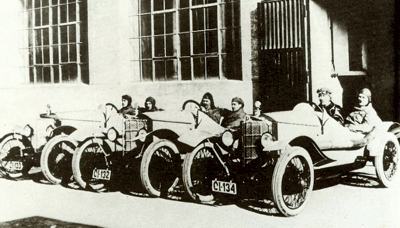 The Steyr-Puch team lines up prior to the start of the 1923 Targa Florio.
The Steyr-Puch team lines up prior to the start of the 1923 Targa Florio.
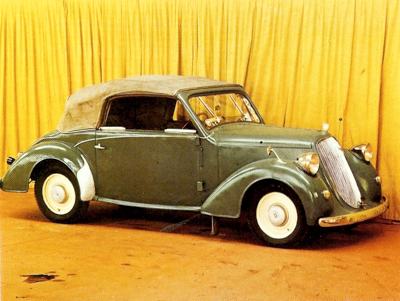 1934 Steyr Coupe. It was powered by a 1385cc four cylinder engine, and approx 2850 were manufactured between 1934 and 1936.
1934 Steyr Coupe. It was powered by a 1385cc four cylinder engine, and approx 2850 were manufactured between 1934 and 1936.
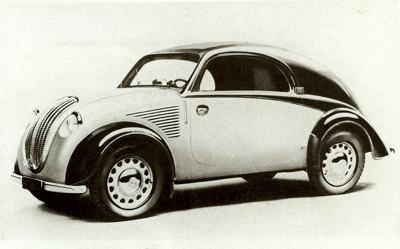 1938 Steyr Type 55. It was fitted with a 25 bhp 1158cc engine. Unusual looking and to our mind almost like a Beetle, it was a development of the Type 50 model.
1938 Steyr Type 55. It was fitted with a 25 bhp 1158cc engine. Unusual looking and to our mind almost like a Beetle, it was a development of the Type 50 model.
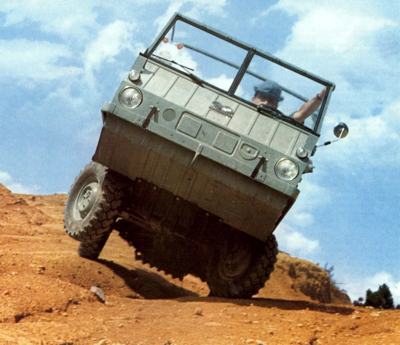 The rugged Steyr Haflinger. It was a four-wheel-drive, powered by an air-cooled twin cylinder engine.
The rugged Steyr Haflinger. It was a four-wheel-drive, powered by an air-cooled twin cylinder engine.
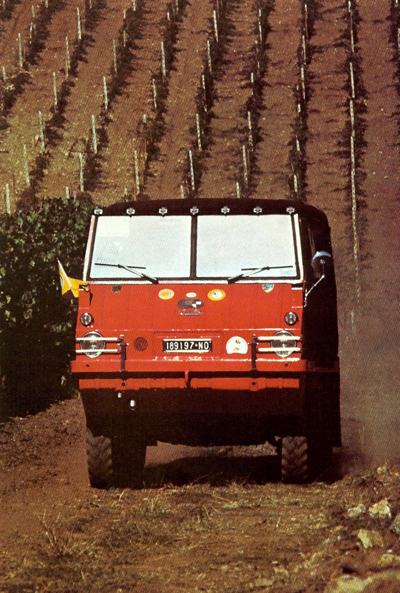 Another shot of the Steyr Puch Haflinger. It was powered by a 643cc air-cooled two-stroke which developed only 27 bhp and gave the off-roader a top speed of 47 miles per hour.
Another shot of the Steyr Puch Haflinger. It was powered by a 643cc air-cooled two-stroke which developed only 27 bhp and gave the off-roader a top speed of 47 miles per hour.
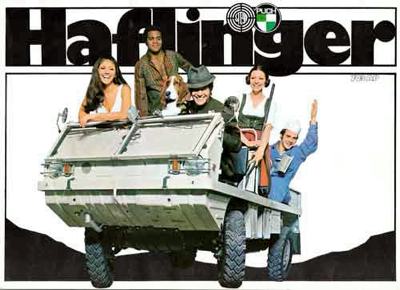 |
The Type XII Steyr Junior
No sooner had Ledwinka left Steyr than the directors realised how stupid they had been, and frantically sent their representatives after him, bearing blank contracts of employment. Ledwinka, it seems, was not one to be swayed by offers of more money, and was not disposed to change jobs yet again, but he did offer to set up a joint drawing office for Steyr and Tatra at Linz in Austria to keep the peace. Although this scheme was not developed, Ledwinka did visit Steyr from time to time to advise on various technical points. His influence was obvious in the 1925 Type XII Steyr Junior, a 1.5-liter six-cylinder model which retained the same overall engine and gearbox design as the larger Steyrs, but featured an all-new chassis underslung on semi-elliptic springs at the front and equipped with independent rear suspension by swing axles.
It was the Steyr Junior that was introduced to the British market in 1925 by Arthur Bray, who had raced alongside Charles Jarrott in the first decade of the century. The new 14/35 hp six-cylinder Steyr Junior was exhibited for the first time and its engine was a wonder of efficiency. Of 1
½ liters capacity with overhead valves and camshaft, it had a built-up crankshaft running in ball bearings, and forced-feed lubrication to engine, gear box and differential from one central point. Unique suspension of differential and drive, with straight-through drive and transverse springing gave independent movement of the rear wheels. It had four-wheel brakes of large dimensions. Two types of bodywork on this chassis were exhibited, a four-five seater touring car of ample proportions and a four-door
Weymann Saloon appointed in typical Steyr luxury.
The Steyr Type VII
The four/five seater ('with Austrian 4-door stream-lined touring body, color myrtle green with leather upholstery to match') cost £440; the saloon was £560 complete. Bray also marketed the 3.3-liter Steyr Type VII, which was obviously intended for the carriage trade: the interior drive limousine. Built upon the highly successful 23.8 hp Steyr chassis, the luxurious 4-door 5/7-seater limousine was a revelation in motoring comfort. Ample power and sturdy design, the finest materials, wonderful springing and reliability ensured superlative luxury for the motor carriage. That slice of luxury cost exactly £1000; while for £25 less, you could have bought the 5/7-seater Coupe de Ville, a "town carriage de luxe, built upon the world famous 23.8 chassis. Silent, powerful, perfectly sprung and commodious, it had an atmosphere of dignity and refinement which placed it in the front rank of chauffeur-driven cars.
A roll extension was provided to give cover to the driver's seat when required. There was a new type of body on the 14 hp chassis exhibited at the 1926 Olympia Show: 'Standard touring body, color dark blue with black leather upholstery,' having a Weymann type of detachable top, which can be fixed during the winter or removed during the summer months, The four doors to this body have glass windows, which can be easily removed and stored behind the back squab when not in use.' Its price was just £510 complete, £40 less than the conventional type of
Weymann Saloon. However, this was Arthur Bray's last year as 'sole factory representative for Great Britain and Ireland'.
A. S. Forsyth
During the following year he was supplanted by A. S. Forsyth, who traded from Sentinel House, Southampton Row, near the Strand in London. The Steyr output was never large, averaging around 1000 cars a year at this period, and it is unlikely that too many found their way to Britain. There was a new small Steyr in 1928. This was the 16/40hp Type XX, which followed the old Ledwinka layout, but had a swept volume of 2.06 liters ; it cost £555 with Weymann saloon coachwork, £50 more than the equivalent 14/35 hp model. By now, Steyr had taken over the British agency themselves, and were running it from premises in Upper St Martins Lane. They were also offering a new big six, the 4-liter 29/70, which had one-shot chassis lubrication and vacuum servo-assisted Bosch-Dewandre four-wheel brakes.
Dr Ferdinand Porsche
A 'Viennese 4-door 7-seater Pullman Limousine with rich equipment' cost £ 1000 complete. Now Steyr were looking for a new chief engineer, and their choice fell on Dr Ferdinand Porsche, who had been working for Mercedes-Benz. Annoyed by the Mercedes-Benz group's unadventurous marketing policies, Porsche accepted the Steyr offer in January 1929, and quickly developed a remarkable new luxury car, the 37/100hp Austria, which had a 5.3-liter straight-eight engine with dual ignition by magneto and coil and two plugs per cylinder. The crankshaft was carried in nine bearings (none of which were ball bearings) and the four-speed gearbox incorporated an overdrive top speed. It had one-shot lubrication and Lockheed hydraulic four-wheel brakes and, for the first time on a Steyr, a detachable cylinder head.
Front suspension was by conventional semi-elliptics, while the rear was independently sprung, with swing axles. The car was shown at the Paris Salon and at Olympia, where the cabriolet was offered at £1550. But Steyr was soon caught in the economic collapse of the Depression. The result was that Steyr had to be bailed out by Austro-Daimler, 'who were developing a revolutionary straight-eight with. independent suspension and a backbone chassis. Steyr Austria was thus strangled at birth. Porsche also resigned, and set up his famous Porsche Buro design consultancy in Stuttgart. However, after the Austro-Daimler link-up (which became a fully fledged takeover in 1935), Steyr's mainstay was another Porsche design. This was the Type XXX, which had a 2078cc six-cylinder power unit which Porsche had originally devised for Mercedes-Benz.
The Steyr Type XXX
Alas, compared with the old Ledwinka units, it was a pretty dull hunk of metal, with plain bearings and pushrod overhead valves; however, the chassis layout was taken from the old Type XII, and was as unconventional as ever. In any case, the effect of the bank crash had been catastrophic: in 1929, Steyr built just under 5000 cars and 1000 trucks. In 1930, they produced twelve vehicles, though they maintained the London angency and exhibited at Olympia that year. The fact that they were an offshoot of the world's biggest small-arms company was some insurance against total collapse and, gradually, the company worked its way back to a degree of health, initially concentrating on the stolid Type XXX, which was gradually developed into the 2.3-liter 530 of 1936.
The Ugly but Popular Type 50 Kleinwagen
There was unconventionality, too, starting with the 1934 120, which had a 2-Iitre engine in a platform chassis with independent front suspension by double transverse-leaf springs, and streamlined coachwork; 1200 were sold before it was developed into the 2.3-liter 220 in 1937. There was also economy: a brief interlude of licence-built Opels was followed in 1934 by the announcement of the Type 100, which ought to have pleased Hans Ledwinka, as it was exactly the type of car he had advocated over a decade earlier, a cheap (and ill-proportioned) economy car with a 1.4-liter side-valve engine. 1936 saw an even smaller Steyr, the Type 50, with a flat-four engine of novel aspect, which had the radiator mounted on the crankcase to minimise its overall dimensions.
The car had the all-round independent suspension of its elders, and was exceptionally ugly, but the little Kleinwagen proved popular. In 1938, a bigger (1158cc) engine was introduced, and the car became the Type 55. Yet, despite its exaggerated streamlining, it could not go much faster than 50 mph. Total production of Types 50 and 55 up to the end of production in 1940 was around 13000. During the war, Steyr produced an ingenious 3.6-liter air-cooled V8, but only the Wehrmacht benefitted from this, and it never saw peacetime production. Instead, Steyr devoted themselves to the production of modified Fiats for the Austrian market, endowing them with such home-grown features as swing axles and a Steyr-built flat-twin power unit.
The Steyr Haflinger Series
In the 1960s, the Steyr company made a great impact with their Haflinger series. These 4 x 4 vehicles were probably the most versatile off-road vehicles ever. produced. Powered by little air-cooled engines, usually of about 650 cc, they were able to scale seemingly impossible slopes. This was due to an ingenious transmission system that featured 'fiddle-type' levers that could lock either differential. The Haflinger (pony) proved very popular with many armies, and in the early 1970s, a 'super' model was produced with the option of six-wheel drive. This vehicle, the Pinzgauer (a breed of Austrian carthorse), had a retail price in Britain of £6000. Ironically enough, the design office that created these cars was headed by Erich Ledwinka, son of Hans, who had corlceived the first Steyr cars three decades earlier.
Steyr-Daimler-Puch America
In the mid 1970's "Steyr-Daimler-Puch America" was incorporated in Connecticut to manage importation and distribution of bicycles and mopeds. Puch Austro-Daimler bicycles remained in production at Graz in Austria until the motorcycle and bicycle fabrication portions of the company there were sold in the mid 1987 to Piaggio & C. S.p.A. of Italy. Because of their extreme durability and toughness Steyr products won many enthusiastic friends around the world. In 1987, Steyr-Daimler-Puch AG began selling portions of its different production lines to form separate companies, which included Steyr Nutzfahrfahrzeuge AG (SNF) (still based in Steyr) for truck manufacturing, Steyr Bus GmbH (in Vienna) for bus manufacturing, Steyr-Daimler-Puch Fahrzeugtechnik AG (SFT) (in Graz) for assembly of automobiles and, in 1990, Steyr Tractor (Steyr Landmaschinentechnik AG).
Other production lines were also spun off or sold outright to form independent companies, including Puch's motorcycle division going to Piaggio and Steyr Mannlicher producing weapons. In 1990, the diesel engine division was spun off into Steyr Motorentechnik GmbH, which in 2001 became an independent company, renaming itself Steyr Motors GmbH. Steyr Landmaschinentechnik AG (Steyr Tractor) was sold to Case Corporation in 1996 and renamed Case Steyr Landmaschinentechnik (and is part of CNH since 1999). Automobile production remained with Steyr-Daimler-Puch Fahrzeugtechnik (SFT) until Magna International acquired a majority holding, in 1998, and in 2001–2 SFT was absorbed fully by Magna, becoming Magna Steyr. In 1998, the production of military vehicles was sold to an Austrian investor company, which named it Steyr-Daimler-Puch Spezialfahrzeug GmbH (SSF). In 2003, SSF was sold to the U.S. company General Dynamics, a defence equipment manufacturer.
